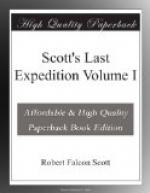Tuesday, May 16.—The north wind continued all night but dropped this forenoon. Conveniently it became calm at noon and we had a capital game of football. The light is good enough, but not much more than good enough, for this game.
Had some instruction from Wright this morning on the electrical instruments.
Later went into our carbide expenditure with Day: am glad to find it sufficient for two years, but am not making this generally known as there are few things in which economy is less studied than light if regulations allow of waste.
Electrical Instruments
For measuring the ordinary potential gradient we have two self-recording quadrant electrometers. The principle of this instrument is the same as that of the old Kelvin instrument; the clockwork attached to it unrolls a strip of paper wound on a roller; at intervals the needle of the instrument is depressed by an electromagnet and makes a dot on the moving paper. The relative position of these dots forms the record. One of our instruments is adjusted to give only 1/10th the refinement of measurement of the other by means of reduction in the length of the quartz fibre. The object of this is to continue the record in snowstorms, &c., when the potential difference of air and earth is very great. The instruments are kept charged with batteries of small Daniels cells. The clocks are controlled by a master clock.
The instrument available for radio-activity measurements is a modified type of the old gold-leaf electroscope. The measurement is made by the mutual repulsion of quartz fibres acting against a spring—the extent of the repulsion is very clearly shown against a scale magnified by a telescope.
The measurements to be made with instrument are various:
The ionization of the air. A length of wire charged with 2000 volts (negative) is exposed to the air for several hours. It is then coiled on a frame and its rate of discharge measured by the electroscope.
The radio-activity of the various rocks of our neighbourhood; this by direct measurement of the rock.
The conductivity of the air, that is, the relative movement of ions in the air; by movement of air past charged surface. Rate of absorption of + and — ions is measured, the negative ion travelling faster than the positive.
Wednesday, May 17.—For the first time this season we have a rise of temperature with a southerly wind. The wind force has been about 30 since yesterday evening; the air is fairly full of snow and the temperature has risen to -6 deg. from -18 deg..
I heard one of the dogs barking in the middle of the night, and on inquiry learned that it was one of the ‘Serais,’ [22] that he seemed to have something wrong with his hind leg, and that he had been put under shelter. This morning the poor brute was found dead.




